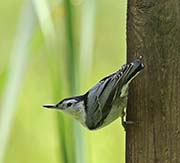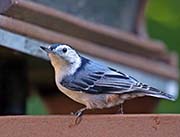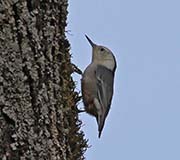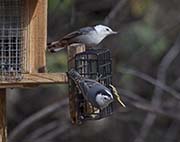White-breasted Nuthatch - Sitta carolinensis
| Length | |
| Wingspan | |
| Weight | |
| Clutch Size | |
| Chicks at birth | |
| IUCN Conservation Status | |
Continents: |
The White-breasted Nuthatch is the largest nuthatch. Their back and uppertail are bluish-gray, the underparts are white and under the tail is rust-colored. They have a black cap and black eye line with a white supercilium (eyebrow). Their tail is short and square. Both sexes look similar although the females and youngsters have duller heads and paler underparts. Their bills are long and may be slightly curved upward.
Diet: White-breasted Nuthatches eat insects, spiders, nuts, seeds and berries. They forage on the trunk and branches of trees. Unlike woodpeckers and creepers, they can climb down a tree head first looking for food. Their feet (three toes forward, one back) are short and sturdy with long toes and sharp claws. They will store seeds in trees under bark, in poles, and under loose house shingles for later consumption. They usually cover them with moss or lichen.
Courtship: White-breasted Nuthatches are monogamous. The male will bow to the female and spread his tail while drooping his wings and then sway back and forth. He will also feed her.
Nesting: White-breasted Nuthatches nest in cavities that woodpeckers have excavated or in natural tree cavities. The female builds a nest shaped like a cup from fur, bark, dirt, grass, shredded bark, feathers, etc. They coat the entrance to the nest hole with noxious-smelling insects. This may help to keep predators away. The number of eggs laid varies from 3-10.
Habitat and Range: The White-breasted Nuthatch is found throughout most of U.S. and into Canada and Mexico. They prefer mature open woods, especially deciduous stands. and may require the presence of oak trees.
Plumage/Molt: A complete molt after the breeding season (June-October), usually in the breeding area. Sometimes there may be a partial molting before the breeding season.
Vocalization: No information.
Migration: White-breasted Nuthatches are not known to migrate.
Tongue/feet: No information.
Bibliography:
- Harrap, Simon and David Quinn , Chickadees, Tits, Nuthatches & Treecreepers,Princeton University Press, 1995
- Sibley, David Allen, The Sibley Guide to Bird Life & Behavior,Alfred A. Knopf, New York, 2001
- http://www.birds.cornell.edu The Cornell Lab of Ornithology, Accessed June, 2012
- http://en.wikipedia.org The Free Encyclopedia, Accessed June, 2012










